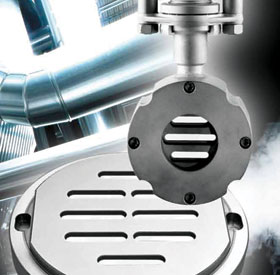

The level of quality attainable in controlling a steam plant is heavily dependent on the dynamic characteristics of the system comprising the control element, actuator and controller. The control parameters for sliding gate valves relating to dynamic behaviour are clearly superior to those for conventional control valves. As a result, the highly responsive dynamics not only improve the control quality but also form the basis for control circuits with very short reaction times. This has proved to be the key factor in steam savings of up to 30%. Current comparisons of steam plant operators show that savings of this magnitude are attainable only by installing a sliding gate valve in place of a traditional control valve.
The most important prerequisites for short reaction times in a control element are short strokes, small actuators and low actuation forces resulting from these. All of these characteristics come together in the sliding gate valve. As it operates, two slotted plates slide against each other transversely to the direction of flow. Thus, the sliding gate valve seals itself without the need for a metallic seat. The typical stroke between opened and closed is a mere 6-9 mm. One of the most noteworthy advantages stemming from this operating principle is the low actuation force required for the positioning movements.
Control dynamics at the highest performance level
By analysing its frequency response, the dynamics of a control valve can be evaluated in terms of its control performance. This aspect was studied experimentally for different control valve systems. The general conclusion is that the use of sliding gate valves in a control circuit results in higher critical gains. On the one hand, therefore, the process controller can be set ‘more aggressively’, while, on the other, overshooting is reduced when approaching a changed set point value, which is also reached more quickly.
Depending on the plant and process, it is therefore possible to tap into potential additional savings simply by exchanging a globe style valve for a sliding gate valve. By doing so, the quantities of steam fed unnecessarily into the system by overshooting action are reduced. This is supported by the figures recorded by operators of different steam systems.
Chinese tobacco manufacturer, Hongta Tobacco, reduces steam consumption by 30%
In the three lines at the Chinese tobacco manufacturer, Hongta Tobacco, the tobacco is conditioned at different temperatures. The process variable defining the quality is the temperature setting at 60, 65 or 70°C. Depending on the temperature setting required, previously Hongta Tobacco had required up to 990 kg of steam per hour for this process. The plant operator replaced traditional globe style valves in this steam facility with sliding gate valves. Then the temperature control parameters were readjusted and the resulting steam consumption measured. Afterwards, the steam consumption fell in the 60 degree line by 200 kg/h, or 36%, 65 degree line by 200 kg/h, or 25% and 70 degree line by 150 kg/h, or 17% - the investment in sliding gate valves paid-off within a few months.
Palm oil producer Palmaju Edible Oil saves five tons of steam per day
Besides the advantages that sliding gate valves can bring to systems, they are also easy to automate. The potential savings that can be achieved from a sliding gate valve incorporating an intelligent positioner are impressively documented by the operator of a palm oil plant, Palmaju Edible Oil, in Johor, Malaysia. By using a small sliding gate valve with a nominal size of DN32 with an electro-pneumatic positioner instead of a self acting pressure regulator, Palmaju Edible Oil was able to reduce the steam consumption by five tons per day. Based on the energy generating costs in Malaysia the savings potential amounts to over €25 000 per year for the plant operator.
With integrated process controller
As an option, the 8049 positioner used here has an integrated process controller for local control tasks. This version of the positioner with an IPC process controller combines the function of a positioner with that of a process controller. Thus, it is possible to set up local control circuits as found commonly in steam circuits, with minimum cost and effort involved in installation.
The sensor for the process variable is connected directly to the controller on the valve and the adjustments needed are carried out on location using a keyboard with a display or with the ‘DeviceConfig’ configuration software. Due to the excellent control quality, the electro-pneumatic positioner which controls the sliding gate valve pays-off within a few weeks in steam systems. By minimising the work required for installation and cabling, converting from manually-controlled valves to automated valves can be achieved extremely smooth.
Short stroke means less wear
In the sliding plate principle with its surface seal formed by the plates in the throttling element, the pressure of the medium against the moving valve plate assists the sealing function of the valve. This functional principle produces a self-lapping effect by the moving valve plate. This seal between the plates is therefore significantly less prone to fail and leakage rates of less than 0,0001% of the Kvs-value are achieved.
In addition, the slotted plates suffer hardly any wear as they slide against each other so that these valves combine long service lives with a high level of enduring leak tightness, even under the severe conditions they face in steam systems, for example. As an option, sliding gate plates are also available in carbon, so that an excellent seal is assured even at very high temperatures with a hard/soft combination of materials. The very short stroke is also a factor in service life: short motion paths and switching times protect the packing and the actuator.
For more information contact Rowan Blomquist, Macsteel Fluid Control, +27 (0)31 581 7803, [email protected], www.macsteel.co.za

© Technews Publishing (Pty) Ltd | All Rights Reserved